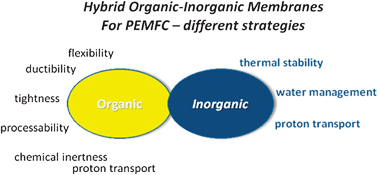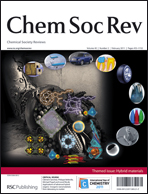This critical review presents a discussion on the major advances in the field of organic–inorganic hybrid membranes for fuel cells application. The hybrid organic–inorganic approach, when the organic part is not conductive, reproduces to some extent the behavior of Nafion where discrete hydrophilic and hydrophilic domains are homogeneously distributed. A large variety of proton conducting or non conducting polymers can be combined with various functionalized, inorganic mesostructured particles or an inorganic network in order to achieve high proton conductivity, and good mechanical and chemical properties. The tuning of the interface between these two components and the control over chemical and processing conditions are the key parameters in fabricating these hybrid organic–inorganic membranes with a high degree of reproducibility. This dynamic coupling between chemistry and processing requires the extensive use and development of complementary ex situ measurements with in situ characterization techniques, following in real time the molecular precursor solutions to the formation of the final hybrid organic–inorganic membranes. These membranes combine the intrinsic physical and chemical properties of both the inorganic and organic components. The development of the sol–gel chemistry allows a fine tuning of the inorganic network, which exhibits acid-based functionalized pores (–SO3H, –PO3H2, –COOH), tunable pore size and connectivity, high surface area and accessibility. As such, these hybrid membranes containing inorganic materials are a promising family for controlling conductivity, mechanical and chemical properties (349 references).

You have access to this article
 Please wait while we load your content...
Something went wrong. Try again?
Please wait while we load your content...
Something went wrong. Try again?


 Please wait while we load your content...
Please wait while we load your content...